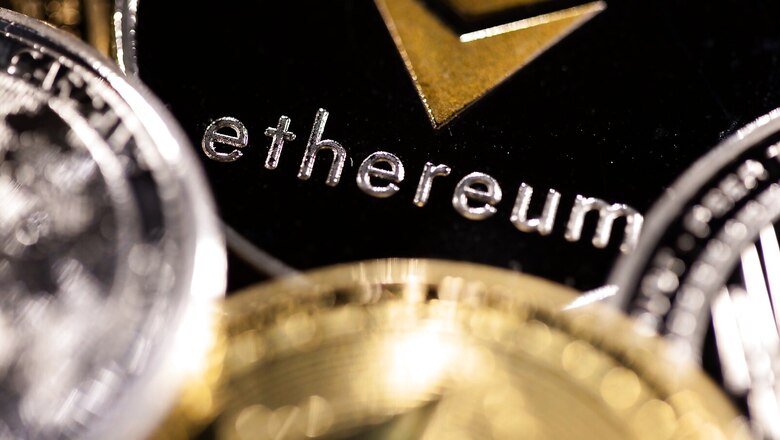
views
Starting September 6, Ethereum will transform fundamentally. The blockchain will completely transition from its present, energy-guzzling Proof-of-Work state (PoW) to the 99.95% more energy-efficient Proof of Stake (PoS).
However, the second-largest crypto, with a market cap of $192,894,011,946 and currently trading at $1,577, is struggling to gain some ground of late. It has dipped about 8% in the last week.
Naturally, investors are experiencing anticipatory jitters in the wake of this mega merge, given that the crypto community, especially PoW miners are a divided lot on this one. Also, rising inflation rates globally, and consequently, interest rate hikes are pushing people towards investing in less-risky, conservative asset classes like debt.
But how will this merge impact the blockchain and the crypto-verse at large?
Vikram Subburaj, CEO of Giottus Crypto Platform, says: “The Merge is the transition of Ethereum (ETH) blockchain to the Proof-of-Stake (PoS) consensus mechanism, which will result in a 90% net drop in annual issuance of ETH. In the short term, the merge may mean high volatility in ETH prices depending on its success and outcomes from it.”
“But over the long-term, though, this will make Ethereum a stronger crypto asset. The Merge may lead to forked chains similar to Ethereum Classic (ETC) that split from Ethereum in 2016,” he adds.
What Will Change for ETH?
Lots of things. For one, there is about 99.95% less energy consumption on the way. Then, there’s speed. The current chain processes around 30 transactions per second. Post the merge, it will be equipped to take on 1,00,000 transactions every second.
This speed will be achieved via sharding. Look at it this way. If you have 10 official tasks to finish in a day, you’d be overwhelmed. Chances are, you’ll slow down. But if you delegate five of them to others, you’ll have multiple hands working on them. Naturally, the work will get done faster.
Right now, all transactions on the ETH blockchain run on a single blockchain, which has consecutive blocks. After sharding, there will be multiple chains running parallel. That will make scaling easier, which would bring about greater usage and, ultimately, demand for Ethereum.
Dileep Seinberg, Founder & CEO of MuffinPay, Bill Payment & Utility Crypto, says: “Ethereum’s successful adoption to PoS will demonstrate that such a massive system is capable of operating on a sizable scale while using minimal energy. This is expected to encourage the development of even more ambitious Web 3.0 initiatives on the network. Miners will no longer need to solve cryptographic conundrums to validate new blocks once proof of stake is implemented. As an alternative, they will add ether tokens to a pool. Think of these tokens as lottery tickets: the right to validate the following block and the associated prizes is yours if your token number is called. The market appears to be generally optimistic about Ethereum’s transition and long-term potential.”
However, there will be no reduction in the transaction costs or gas fees, as opposed to the widespread assumption. Gas costs have often been a contentious issue for ETH users. Their prices had touched as high as $40 in May this year. However, as of August 2022, it stood at $1.60.
Since transaction costs are a function of network demand and its processing capacity, nothing significant is set to change on this end. As per the Ethereum website: “The Merge is a change of consensus mechanism, not an expansion of network capacity, and will not result in lower gas fees.”
Even when it comes to processing speed, not much improvement is expected. Right now, ETH’s main PoS chain i.e Beacon adds a new block every 13.3 seconds. After the merge, it will just take 10% less time to do so. And since speed on Layer 1 will remain the same, nothing is set to change as such.
What’s In Store for Developers?
It’s no secret that developers are flocking to Web 3.0 in droves. As per the 2021 Electric Capital Developer Report, since 2021, the number of developers in the space has skyrocketed by 80%.
Out of this, ETH has the lion’s stake, with 4,000 developers joining every month, on average. The popularity is such that one in every five developers chooses Ethereum to begin with. And they find these minor upgrades in speed and processing time post-merge to be insignificant.
“Currently, the majority of the decentralised apps (DApps) are built on Ethereum blockchain. With it being more energy efficient and faster, the number of projects on this blockchain will increase, thanks to enhanced bandwidth. Furthermore, the so-called Ethereum killers might be under pressure as they may lag behind in attracting new and more projects,” notes Seinberg.
What Should Investors Do?
Nothing much, says Subburaj. “For now, investors should only hold Ethereum on a wallet or exchange that supports the Merge and any new forks. All coins will be automatically transferred to the new blockchain while any new forked coins will also be issued to the investor. NFT holders are encouraged to hold their NFTs in private wallets.”
Read all the Latest Business News and Breaking News here


















Comments
0 comment